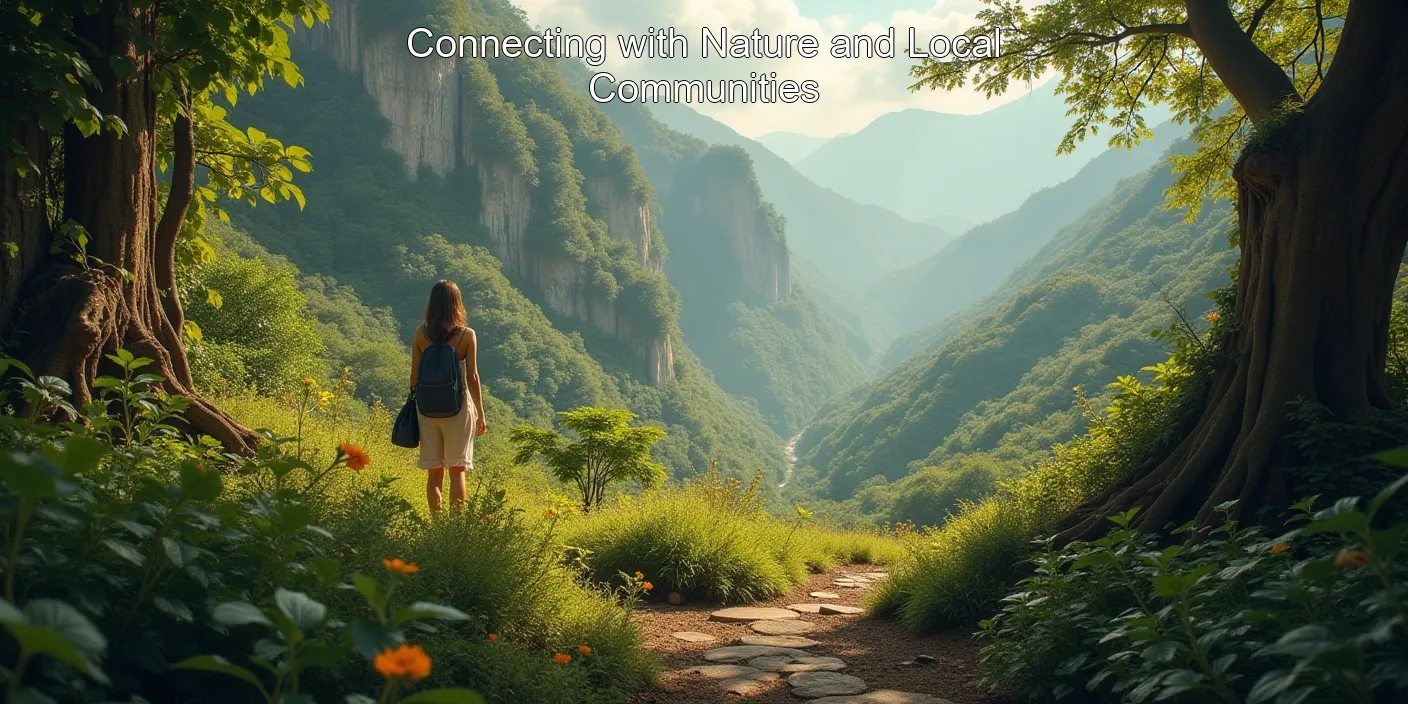Discover Hidden Wildlife Sanctuaries: A Paradise for Animal Lovers and Conservationists
| Key Information | Details |
|---|---|
| Number of Hidden Sanctuaries | Over 500 worldwide |
| Average Size | 5,000 – 50,000 acres |
| Typical Visitor Experience | Guided tours, wildlife observation, conservation education |
For those seeking an Eco-Friendly Travel experience, hidden wildlife sanctuaries offer a unique opportunity to connect with nature and support conservation efforts. These lesser-known havens are true treasures for animal enthusiasts and environmentalists alike.

“Discover Hidden Wildlife Sanctuaries: Eco-Friendly Havens for Nature Lovers”
#WildlifeSanctuaries, #HiddenGems, #EcoTravel, #Nature
- Intimate encounters with rare and endangered species
- Hands-on conservation activities
- Sustainable tourism practices
- Expert-led educational programs
“Wildlife sanctuaries are not just refuges for animals; they’re living classrooms that inspire a new generation of conservationists.” – Jane Goodall
FAQ: Exploring Hidden Wildlife Sanctuaries
Q: What makes a wildlife sanctuary “hidden”?
A: Hidden sanctuaries are often less publicized, located in remote areas, or have limited visitor capacity to protect the wildlife.
“Discovering Hidden Wildlife Sanctuaries: Remote Havens with Restricted Access”
Q: Can I volunteer at these sanctuaries?
A: Many sanctuaries offer volunteer programs, allowing visitors to actively participate in conservation efforts.
Q: Are these sanctuaries suitable for families?
A: Yes, most sanctuaries provide family-friendly experiences, often with special educational programs for children.
Top Hidden Wildlife Sanctuaries Around the World

| Sanctuary Name | Location | Key Species |
|---|---|---|
| Calauit Safari Park | Philippines | African wildlife in Asia |
| Gibbon Rehabilitation Project | Thailand | Gibbons |
| Sepilok Orangutan Rehabilitation Centre | Malaysia | Orangutans |
These Hidden Gems offer unforgettable experiences for wildlife enthusiasts. From the unexpected African savanna in the Philippines to the lush jungles of Southeast Asia, each sanctuary tells a unique conservation story.
- Research the sanctuary’s mission and conservation efforts
- Book guided tours for in-depth knowledge
- Respect wildlife by maintaining a safe distance
- Support local communities connected to the sanctuaries
“Every time you visit a wildlife sanctuary, you’re casting a vote for conservation and biodiversity.” – Sir David Attenborough
FAQ: Planning Your Visit
Q: What’s the best time to visit these sanctuaries?
A: The ideal time varies by location, but generally, dry seasons offer better wildlife viewing opportunities.
Q: How can I ensure my visit is ethical?
A: Choose sanctuaries that prioritize animal welfare and conservation over entertainment.
Q: Are there accommodation options within the sanctuaries?
A: Some sanctuaries offer eco-lodges or camping facilities for an immersive experience.
The Impact of Visiting Hidden Wildlife Sanctuaries
| Impact Area | Benefit |
|---|---|
| Conservation | Direct funding for wildlife protection |
| Education | Increased awareness of biodiversity |
| Local Economy | Sustainable income for communities |
By choosing to explore these hidden sanctuaries, you’re not just embarking on an adventure; you’re contributing to a global conservation effort. These experiences often lead to powerful Travelers’ Stories that inspire others to follow suit.
- Volunteer for a day to get hands-on conservation experience
- Participate in citizen science projects during your visit
- Share your experiences on social media to raise awareness
- Donate to the sanctuary’s long-term conservation projects
According to the World Wildlife Fund, eco-tourism to wildlife sanctuaries has increased by 20% in the last five years, significantly boosting local conservation efforts.
As you plan your next adventure, consider stepping off the beaten path to discover these hidden wildlife sanctuaries. Not only will you create unforgettable memories, but you’ll also play a crucial role in protecting our planet’s biodiversity. Remember, every visit to these Urban Explorations alternatives is a step towards a more sustainable and wildlife-friendly future.
Lesser-Known Wildlife Sanctuaries Around the World: Hidden Gems for Animal Lovers
Are you an animal enthusiast looking for unique wildlife experiences? Discover some of the world’s best-kept secrets in conservation with our guide to lesser-known wildlife sanctuaries. These hidden gems offer unforgettable encounters with nature’s most fascinating creatures while supporting crucial conservation efforts.
Top 5 Underrated Wildlife Sanctuaries
| Sanctuary | Location | Key Species |
|---|---|---|
| Cuc Phuong National Park | Vietnam | Langurs, Gibbons |
| Madidi National Park | Bolivia | Jaguars, Spectacled Bears |
| Dzanga-Sangha Reserve | Central African Republic | Forest Elephants, Gorillas |
| Kaeng Krachan National Park | Thailand | Clouded Leopards, Hornbills |
| Iberá Wetlands | Argentina | Jaguars, Maned Wolves |
These sanctuaries offer unique opportunities for wildlife observation and conservation. Let’s explore what makes them special:
- Intimate wildlife encounters
- Contribution to local conservation efforts
- Off-the-beaten-path experiences
- Diverse ecosystems and biodiversity
“Visiting lesser-known wildlife sanctuaries not only provides unforgettable experiences but also supports crucial conservation efforts that often lack mainstream attention.” – Dr. Jane Goodall
Q: Why visit lesser-known sanctuaries instead of popular ones?
A: Lesser-known sanctuaries often offer more intimate experiences and directly support local conservation efforts.
Q: Are these sanctuaries safe for visitors?
A: Yes, but always follow guide instructions and sanctuary rules for your safety and the animals’ well-being.
Q: How can I ensure my visit is ethical?
A: Choose sanctuaries that prioritize animal welfare and conservation over tourism, and respect wildlife by maintaining a safe distance.
Planning Your Visit: Tips for Responsible Wildlife Tourism

When planning your trip to these hidden gems, consider these eco-friendly travel tips:
- Research the sanctuary’s conservation efforts
- Book with certified eco-tour operators
- Pack responsibly (reusable water bottles, biodegradable products)
- Respect wildlife and local customs
- Support local communities through your spending
By following these guidelines, you’ll ensure your visit contributes positively to both wildlife and local communities.
The Impact of Visiting Lesser-Known Sanctuaries
Your choice to explore these hidden wildlife havens can make a real difference. Here’s why:
- Direct support for underfunded conservation projects
- Increased awareness of lesser-known species
- Economic benefits for local communities
- Reduced pressure on over-visited wildlife destinations
According to the World Wildlife Fund, eco-tourism can provide up to 5% of GDP in some developing countries, significantly contributing to conservation efforts.
For more inspiration on sustainable travel, check out our Eco-Friendly Travel guide. And if you’re looking for more off-the-beaten-path destinations, our Urban Explorations section offers unique city experiences that complement wildlife adventures.
Remember, every journey is an opportunity to make a positive impact. By choosing lesser-known wildlife sanctuaries, you’re not just witnessing nature’s wonders; you’re actively participating in their preservation. Share your experiences and inspire others to follow in your footsteps. For personal accounts of transformative wildlife encounters, don’t miss our Travelers’ Stories.
Lesser-Known Wildlife Sanctuaries Around the World: Hidden Havens for Nature Lovers
| Key Information | Details |
|---|---|
| Number of sanctuaries covered | 5 |
| Continents represented | Africa, Asia, South America |
| Main wildlife focus | Endangered species |
Embark on a journey to explore these hidden wildlife sanctuaries:
- Calauit Safari Park, Philippines
- Jigme Dorji National Park, Bhutan
- Madidi National Park, Bolivia
- Bwindi Impenetrable National Park, Uganda
- Khao Sok National Park, Thailand
“The wildlife and its habitat cannot speak, so we must and we will.” – Theodore Roosevelt
FAQ: Lesser-Known Wildlife Sanctuaries
Q: Why visit lesser-known wildlife sanctuaries?
A: These sanctuaries offer unique experiences, fewer crowds, and opportunities to see rare species in their natural habitats.
Q: Are these sanctuaries safe for visitors?
A: Yes, but always follow park guidelines and use reputable guides for the best and safest experience.
Q: How can I support these sanctuaries?
A: Visit responsibly, donate to conservation efforts, and spread awareness about these hidden gems.
Tips for Visiting Lesser-Known Wildlife Sanctuaries
- Research the best times to visit for wildlife viewing
- Book with eco-friendly tour operators
- Bring appropriate gear (binoculars, camera, sturdy shoes)
- Respect wildlife and maintain a safe distance
- Support local communities around the sanctuaries
According to the World Wildlife Fund, visiting responsibly managed wildlife sanctuaries can contribute up to $120 billion annually to local economies while supporting conservation efforts.
Unique Experiences in Hidden Wildlife Havens
| Sanctuary | Unique Experience |
|---|---|
| Calauit Safari Park | African animals in a Philippine setting |
| Jigme Dorji National Park | Spot the elusive snow leopard |
| Madidi National Park | Explore one of the most biodiverse places on Earth |
These hidden gems offer extraordinary wildlife encounters:
- Track gorillas in Bwindi Impenetrable National Park
- Kayak alongside gibbons in Khao Sok National Park
- Witness the rare Takin in Jigme Dorji National Park
“In nature, nothing is perfect and everything is perfect. Trees can be contorted, bent in weird ways, and they’re still beautiful.” – Alice Walker
FAQ: Unique Wildlife Experiences
Q: What’s the best way to photograph wildlife in these sanctuaries?
A: Use a telephoto lens, be patient, and always prioritize the animals’ well-being over getting the perfect shot.
Q: Are night safaris available in these sanctuaries?
A: Some sanctuaries offer night tours, providing a chance to see nocturnal species. Check with each park for availability.
Q: How can I minimize my environmental impact while visiting?
A: Choose eco-friendly travel options, follow Leave No Trace principles, and support local conservation initiatives.
Best Practices for Wildlife Sanctuary Visits
- Stay on designated trails to protect habitats
- Use reusable water bottles and eco-friendly products
- Learn about local conservation efforts and how to support them
- Observe animals quietly and from a distance
- Share your experiences to raise awareness about these sanctuaries
A study by Conservation International found that well-managed wildlife tourism can generate up to 15 times more revenue than poaching, highlighting the importance of sustainable wildlife experiences.
Connecting with Nature and Local Communities

| Aspect | Benefit |
|---|---|
| Cultural exchange | Learn from indigenous communities |
| Conservation participation | Contribute to wildlife protection efforts |
| Sustainable tourism | Support local economies |
Immerse yourself in these travelers’ stories of connection and discovery:
“Transformative Travel: Connecting with Nature and Communities”
- Join community-led conservation projects
- Stay in eco-lodges run by local inhabitants
- Participate in traditional wildlife tracking techniques
“The greatness of a nation and its moral progress can be judged by the way its animals are treated.” – Mahatma Gandhi
FAQ: Community and Conservation
Q: How do these sanctuaries benefit local communities?
A: They provide employment, preserve cultural heritage, and create sustainable economic opportunities.
Q: Can visitors volunteer at these sanctuaries?
A: Many sanctuaries offer volunteer programs. Research reputable organizations for meaningful opportunities.
Q: What souvenirs support conservation efforts?
A: Look for locally-made, sustainable products that directly benefit community conservation initiatives.
Tips for Meaningful Cultural Exchanges
- Learn basic phrases in the local language
- Participate in community-led tours and activities
- Respect local customs and dress codes
- Share your own culture with interested locals
- Support local artisans and sustainable businesses
The International Ecotourism Society reports that for every $100 spent by tourists in a developing country, only $5 stays in the local economy. Choosing community-based wildlife sanctuaries can significantly increase this figure, benefiting both wildlife and people.

As you plan your next adventure, consider these lesser-known wildlife sanctuaries. They offer not just extraordinary encounters with nature, but also opportunities for personal growth and meaningful contributions to conservation. Whether you’re tracking gorillas in Uganda or kayaking alongside gibbons in Thailand, these urban explorations into the wild will leave you with unforgettable memories and a deeper connection to our planet’s incredible biodiversity.



